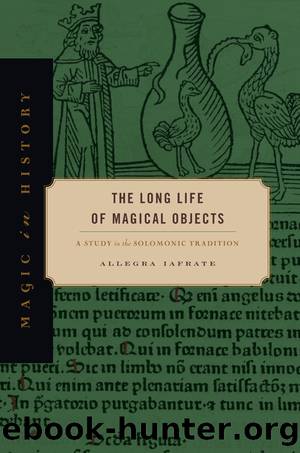The Long Life of Magical Objects by Allegra Iafrate

Author:Allegra Iafrate
Language: eng
Format: epub
Publisher: Penn State University Press
Carpets Flying in the Nights
In 2004, Azhar Abidi published his famous âThe Secret History of the Flying Carpet,â in which he gave as a source for his discoveries the thirteenth-century manuscript, newly discovered in an Iranian castle, of Jewish scholar Isaac Ben Sherira. The essay, full of surprising revelations, such as that the flying mechanism was based on an advanced knowledge of magnetism, proved to be a successful literary experiment, a spoof of academic writing without any scientific basis, which, nevertheless, became a famous internet urban legend.3
For a truly historical approach to the topic, we should instead turn to Marina Warner, who, among other things, has explored the symbolic interpretation of the carpet as a metaphor for the plot (text/textile) and of the role of the omniscient narrator who can see the unfolding of the stories from a privileged birdâs-eye view, as if he himself were flying on a magic carpet.4 Moreover, she has carried out an in-depth analysis of this element in the Arabian Nights, where flying devices figure at various momentsâalthough not as often as we might imagine.
Solomon appears on a flying carpet in âThe City of Brass,â discussed in chapters 2 and 3. The demon Dahesh, imprisoned in a pillar after being defeated by Solomon, describes how the king had led his majestic army in battle while floating in the air, seated on a giant carpet.5 The wondrous device also appears (without Solomon) in the âTale of the Prince Ahmed and the Fairy Peri Banou,â where Houssain, one of the three brothers in the story, buys a carpet that can bring its owner wherever he wishes.6
Neither of these accounts, however, belongs to the most ancient nucleus of the Nights. While the former was added in the nineteenth-century version of the tales but has antecedents dating as early as the ninth century, the latter was probably crafted by Antoine Galland himself (1646â1715), the first translator of the tales.7 The relatively late inclusion of these stories should not necessarily make us doubt the antiquity of some of the motifs they incorporate. As often happens, the Nights are a dense repository of themes developed earlier, a point of arrival rather than of departure. The success of the carpet was immediate and long-lasting, and in Western perception it soon became a favorite element of the wonders of the East, probably also owing to the enthusiasm for flying experiments in eighteenth-century Europe, as Warner suggests.8
In addition to these two textual occurrences mentioned by the scholar, there is a brief but explicit reference to the Solomonic carpet in the âTale of Sympathy the Learned,â also known as âAbu al-Husn and His Slave-Girl.â Tawaddud, the clever slave who shows herself to be wiser than her master, is asked, âWhat man prayed when he was neither on earth nor in Heaven?â She replies, âSulaimÄn prayed upon a carpet hanging in mid-air between heaven and earth.â9 The origin of this tale seems to be as early as the ninth century, although its nucleus was likely crafted in thirteenth-century Egypt.
Download
This site does not store any files on its server. We only index and link to content provided by other sites. Please contact the content providers to delete copyright contents if any and email us, we'll remove relevant links or contents immediately.
| Hadith | History |
| Law | Mecca |
| Muhammed | Quran |
| Rituals & Practice | Shi'ism |
| Sufism | Sunnism |
| Theology | Women in Islam |
The History of Jihad: From Muhammad to ISIS by Spencer Robert(2212)
Nine Parts of Desire by Geraldine Brooks(2011)
The Turkish Psychedelic Explosion by Daniel Spicer(1993)
The First Muslim The Story of Muhammad by Lesley Hazleton(1887)
The Essential Rumi by Coleman Barks(1635)
The Last Mughal by William Dalrymple(1573)
Trickster Travels: A Sixteenth-Century Muslim Between Worlds by Davis Natalie Zemon(1546)
1453 by Roger Crowley(1493)
by Christianity & Islam(1351)
God by Aslan Reza(1336)
Muhammad: His Life Based on the Earliest Sources by Martin Lings(1297)
A Concise History of Sunnis and Shi'is by John McHugo(1278)
Magic and Divination in Early Islam by Emilie Savage-Smith;(1203)
The Flight of the Intellectuals by Berman Paul(1184)
No God But God by Reza Aslan(1161)
Art of Betrayal by Gordon Corera(1136)
What the Qur'an Meant by Garry Wills(1122)
Getting Jesus Right: How Muslims Get Jesus and Islam Wrong by James A Beverley & Craig A Evans(1082)
The Third Choice: Islam, Dhimmitude and Freedom by Durie Mark & Ye'or Bat & Bat Ye'or(1069)
